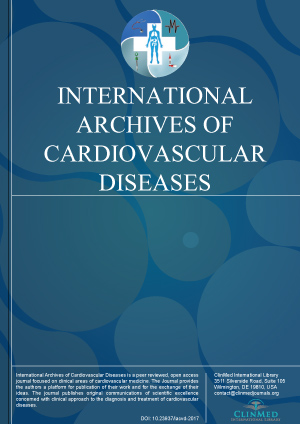Open Access DOI:10.23937/2643-3966/1710039
Complete Heart Block in a Patient with COVID-19
Ricardo J Villasmil, MD, Christian J Lorenzo, MD, Qassem K Abdelal, MD, Jorge I Conte, MD, Natalia Lattanzio, MD, Wilhelmine Wiese-Rometsch, MD and Henry G Cheng, MD
Article Type: Case Report | First Published: March 31, 2021
The severe acute respiratory syndrome coronavirus 2 (SARS-CoV-2) pandemic has been reported to cause cardiac complications including myocarditis, acute myocardial infarction (AMI) and various tachyarrhythmias. We present a 63-year-old male who developed nonreversible symptomatic bradycardia due to advanced atrioventricular block (AV) requiring pacemaker placement in the setting of severe SARS-CoV-2 pneumonia. SARS-CoV-2 is a novel coronavirus identified as the pathogen responsible for causing th...
Open Access DOI:10.23937/2643-3966/1710037
Triple Therapy for Persistent Pulmonary Hypertension Post Left Ventricular Assist Device: A Success Case for Cardiac Transplant
Muhammad O Zaman, MD, Luka Petrovic, MD, Scott Stewart, DNP and Bernard Kim, MD
Article Type: Case Report | First Published: February 24, 2021
Patients with end stage heart failure often develop pulmonary hypertension which resolves after placement of left ventricular assist device (LVAD). Some patients develop persistent pulmonary hypertension despite LVAD implantation. This excludes them from being able to receive a heart transplant. High pulmonary vascular resistance is associated with poor prognosis in patients with LVAD. There are no treatment guidelines available for long term treatment of pulmonary hypertension in LVAD patients ...
Open Access DOI:10.23937/2643-3966/1710036
Mitochondrial Dynamics and Cardiovascular Risk: An Insight at the Molecular Level
Ivan Lozada Martinez, Daniela Torres Llinás and Andres Llamas Nieves
Article Type: Commentary | First Published: February 06, 2021
Mitochondria are cellular organelles; whose function goes beyond generating adenosine triphosphate (ATP). They are part of the machinery involved in the production of substances related to iron, sulfur, and heme group, involved in lipid metabolism, calcium homeostasis, heat generation, cell signaling, stem cell pathway determination, and apoptotic processes. A vast variety of pathologies have been related to mitochondrial deficit, within these, cardiovascular diseases. Mitochondrial dysfunction ...
Open Access DOI:10.23937/2643-3966/1710035
Homocysteine Levels and Cardiovascular Risk: Potential Predictor of Morbidity and Mortality
Ivan Lozada Martinez, Daniela Torres Llinás and Andres Llamas Nieves
Article Type: Commentary | First Published: February 06, 2021
Homocysteine is a sulfurated amino acid, deriving out of methionine from the metabolism of the methyl group. It is a non-protein substance that has been associated with the dynamics of endothelial function, platelet activation, and leukocyte interaction, with the capacity to intensify the inflammatory response in the cardiovascular system, it is therefore considered a potential cardiovascular risk marker. Some studies have evaluated homocysteine in risk groups, where it has been found that the e...
Open Access DOI:10.23937/2643-3966/1710034
Unjustified Referral of Adult Patients with Hypertensive Crisis from a First Level of Care to the Emergency Department
Rodriguez-Zuñiga Jorge, Garcia-Hernandez Jorge Alfredo, Lopez-Vilchis Lizeth Liliana, Ruiz-Mondragon Alberto and Sanchez-Martinez Fatima Alondra
Article Type: Original Article | First Published: January 23, 2021
Hypertensive crisis is one of the main complications of systemic arterial hypertension, which is defined as severe elevation of blood pressure, with figures of more than 220/130 mmHg, these in turn are divided into urgency and emergency, which occurs when there is damage to a target organ. According to the literature, the majority of hypertensive crises that occur are of an urgency type, reported in up to 80% of cases, the latter do not require a rapid decrease in blood pressure, taking up to 72...
Open Access DOI:10.23937/2643-3966/1710033
The Influence of Iterative Reconstruction Technique on the Diagnosis of Coronary Artery Calcification
Ahmed Khamis AlShamakhi, MSc, Rakesh Malhari Jamkhandikar, MD, Yahya Mohammed AlWahshi, MD and Sathiya Murthi Panchatcharam, MSc
Article Type: Original Article | First Published: January 23, 2021
This study was performed in a single center and written informed consent was obtained from all patients. Thirty-one consecutive patients (26 men/5 women) underwent CT calcium score to rule out CAC. Image data were reconstructed with both; filtered back projection (FBP) and different levels of IR algorithms. Both the qualitative and quantitative image quality and subjective diagnostic performance were compared; Agatston scores and calcium density were measured for a total of 100 coronary arteries...

